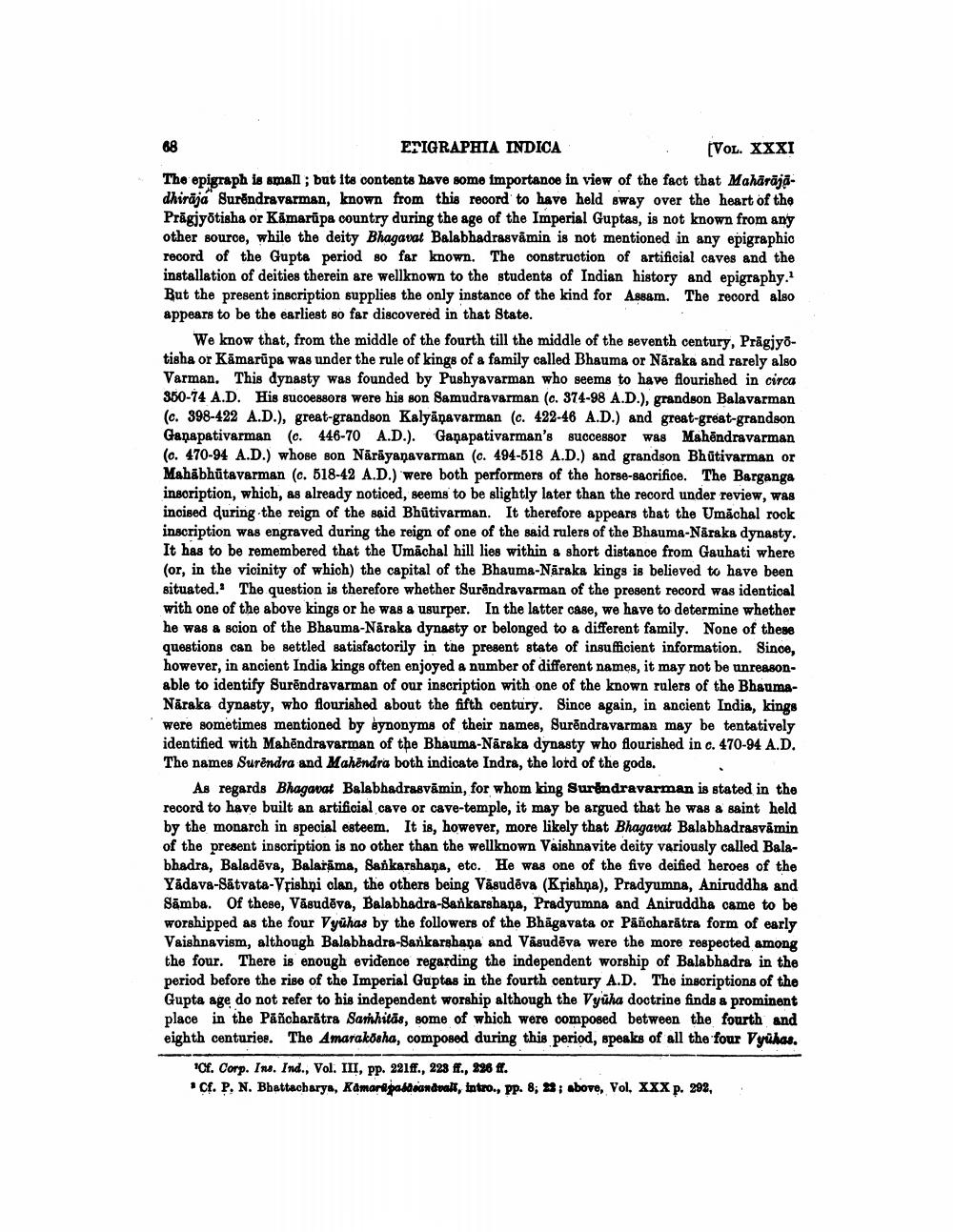________________
ETIGRAPHIA INDICA
(VOL. XXXI The epigraph is small; but its contents have some importance in view of the fact that Maharajadhiraja Surendravarman, known from this record to have held sway over the heart of the Prāgjyotisha or Kamarüpa country during the age of the Imperial Guptas, is not known from any other source, while the deity Bhagavat Balabhadrasvāmin is not mentioned in any epigraphic record of the Gupta period 80 far known. The construction of artificial caves and the installation of deities therein are wellknown to the students of Indian history and epigraphy. But the present inscription supplies the only instance of the kind for Assam. The record also appears to be the earliest so far discovered in that State.
We know that, from the middle of the fourth till the middle of the seventh century, Pragjyotisha or Kamarūpa was under the rule of kings of a family called Bhauma or Näraka and rarely also Varman. This dynasty was founded by Pushyavarman who seems to have flourished in circa 350-14 A.D. His successors were his son Samudravarman (c. 374-98 A.D.), grandson Balavarman (c. 398-422 A.D.), great-grandson Kalyāņavarman (c. 422-46 A.D.) and great-great-grandson Ganapativarman (c. 446-70 A.D.). Ganapativarman's successor was Mahēndravarman (c. 470-94 A.D.) whose son Nārāyaṇavarman (c. 494-518 A.D.) and grandson Bhütivarman or Mahābhūtavarman (c. 518-42 A.D.) were both performers of the horse-sacrifice. The Barganga inscription, which, as already noticed, seems to be slightly later than the record under review, was incised during the reign of the said Bhūtivarman. It therefore appears that the Umāchal rock inscription was engraved during the reign of one of the said rulers of the Bhauma-Näraks dynasty. It has to be remembered that the Umāchal hill lies within a short distance from Gauhati where (or, in the vicinity of which) the capital of the Bhauma-Näraka kings is believed to have been situated. The question is therefore whether Surēndravarman of the present record was identical with one of the above kings or he was a usurper. In the latter case, we have to determine whether he was a scion of the Bhauma-Näraka dynasty or belonged to a different family. None of these questions can be settled satisfactorily in the present state of insufficient information. Since, however, in ancient India kings often enjoyed a number of different names, it may not be unreasonable to identify Surēndravarman of our inscription with one of the known rulers of the BhaumaNāraks dynasty, who flourished about the fifth century. Since again, in ancient India, kings were sometimes mentioned by Synonyms of their names, Surēndravarman may be tentatively identified with Mahēndravarman of the Bhauma-Nāraka dynasty who flourished in c. 470-94 A.D. The names Surendra and Mahendra both indicate Indra, the lord of the gods.
As regards Bhagavat Balabhadrasvāmin, for whom king Surindravarman is stated in the record to have built an artificial cave or cave-temple, it may be argued that he was a saint held by the monarch in special esteem. It is, however, more likely that Bhagavat Balabhadrasvâmin of the present inscription is no other than the wellknown Vaishnavite deity variously called Balabhadra, Baladēva, Balarama, Sankarshaņa, etc. He was one of the five deified heroes of the Yadava-Sätvata-fishni clan, the others being Vasudeva (Krishna), Pradyumna, Aniruddha and Sāmba. Of these, Vāsudēva, Balabhadra-Sankarshana, Pradyumna and Aniruddha came to be worshipped as the four Vyūhas by the followers of the Bhāgavata or Pānoharātra form of early Vaishnavism, although Balabhadra-Sankarshana and Väsudēva were the more respected among the four. There is enough evidence regarding the independent worship of Balabhadra in the period before the rise of the Imperial Guptas in the fourth century A.D. The inscriptions of the Gupta age do not refer to his independent worship although the Vyüha doctrine finds a prominent place in the Pancharătra Samhitas, some of which were composed between the fourth and eighth centuries. The Amarakosha, composed during this period, speaks of all the four Vyükas.
Cf. Corp. Ins. Ind., Vol. III, PP. 221ff., 228 ff., 296 ff. Cf. P. N. Bhattacharya, Kamarilpaddsandvall, intro., pp. 8; 23; above, Vol. XXX p. 292.




